Saturday, April 1
We arrived at 3:30am at the Colombo airport, actually in Negombo. There are tons of anti-drug posters in the passport line. Sri Lanka must have lots of drugs. Our guide Ubali picked us up at the airport (it’s nice when someone is there with a sign with your name on it) and took us to a fancy hotel nearby to sleep for a few hours. Their breakfast buffet was instructive, featuring hoppers (little bowls made out of fermented rice flour and coconut milk) and string hoppers (loosely woven noodles formed into little discs), several curries and sambals, and fruit.
Then we were on the road. We bypassed the capital, Colombo, and headed to a historic fort town on the south coast, Galle. We toured a small very old Dutch church, and walked around town. The guide points out the beach was lined with buildings until the 2004 tsunami.
As usual, people ask if we are brothers, and where we are from. We say, customarily, “California”. Interestingly, at least two people have asked whether California was part of America. In previous trips, California has been definitive as a location.
Ray was thrilled to discover that the price for postcard postage was 70 rupees, or about 23 cents. The cards themselves were only 60 rupees. We found some more coffee and the juice of a fruit we had never heard of (Ambarella), rejoined our driver, and headed east. There were signs on the freeway warning of danger from peacocks. Peacocks are pervasive all over Sri Lanka. So are monkeys.
The first hotel was “Wadula Safari”, and it wasn’t easy to locate. Our driver was not familiar with the location, and had to ask different people, some by leaning out the window, and some by phone. Almost unique among modern people, he pulls over to the side of the road to use his cell phone. The Google preferred route wanted to put us on roads which did not exist.
It turned out, finally, that they way you get there is to communicate with the owner, who meets you at a little Buddhist shrine in his tuk-tuk, and takes you down a bumpy road about 10 minutes to the place. We stayed in a bungalow, with a little lake nearby with water birds, water buffalo, and crocodiles. A wire kept the buffaloes away. There wasn’t really any cell service, and it didn’t matter because even where there was, our phones weren’t getting anything from the Internet. There was WiFi, though, which still was slow and unreliable. Dinner was “kottu”, and it was introduced dramatically by removing an upside-down bowl on plates already on the table. We never saw it made, but apparently it’s like Benihana, a whole bunch of knife work cutting up pieces of roti and vegetables and meat. It was also served pretty much in the dark, and it was very tasty.
The lights came on randomly during the night until we unscrewed the light bulbs.
Sunday, April 2
In the morning the tuk-tuk took us back to the road, and Ubali drove us back towards Galle to the entrance of Bundala National Park along the south coast. A birdwatching guide and his driver met us there, and as we entered the park there were immediately several species of water birds. We spent a few hours in the park, saw tons of water birds and several perching ones, an elephant, and a spotted deer chasing a wild boar.

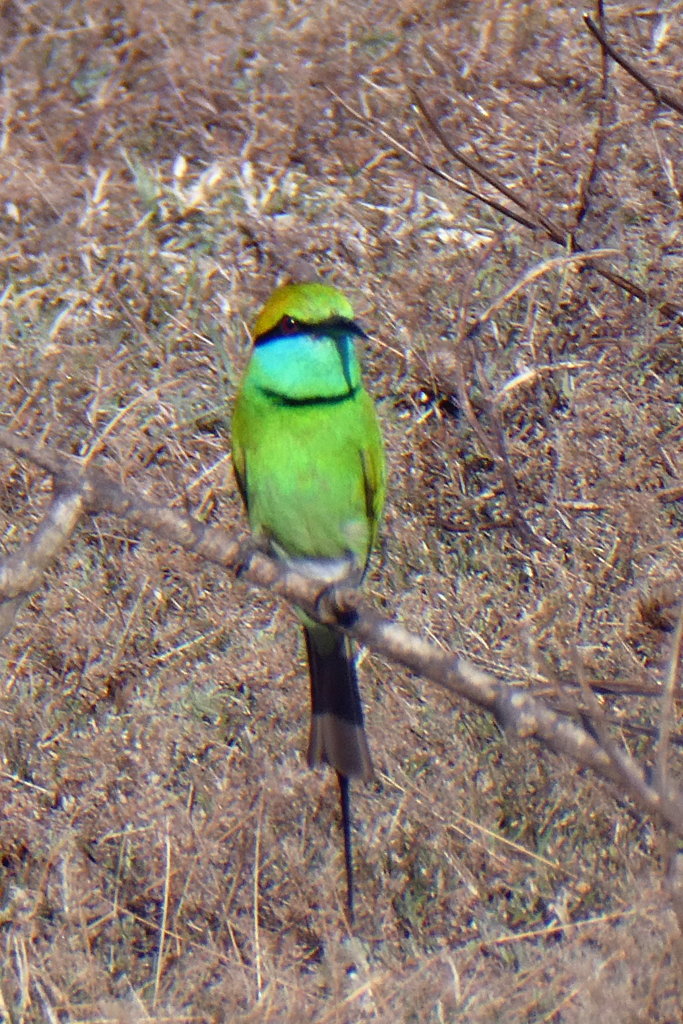
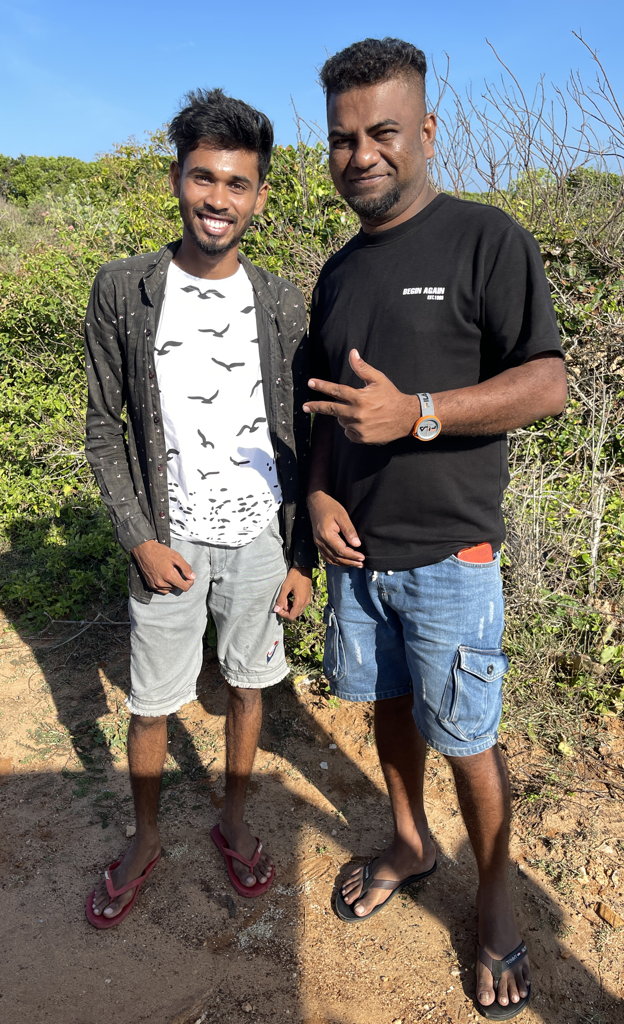
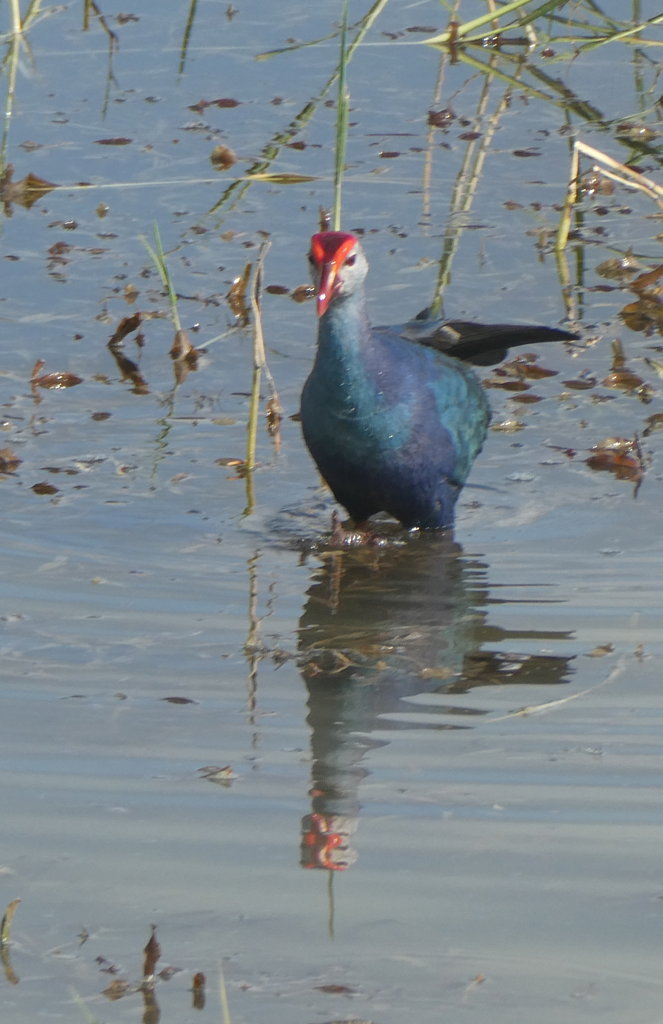
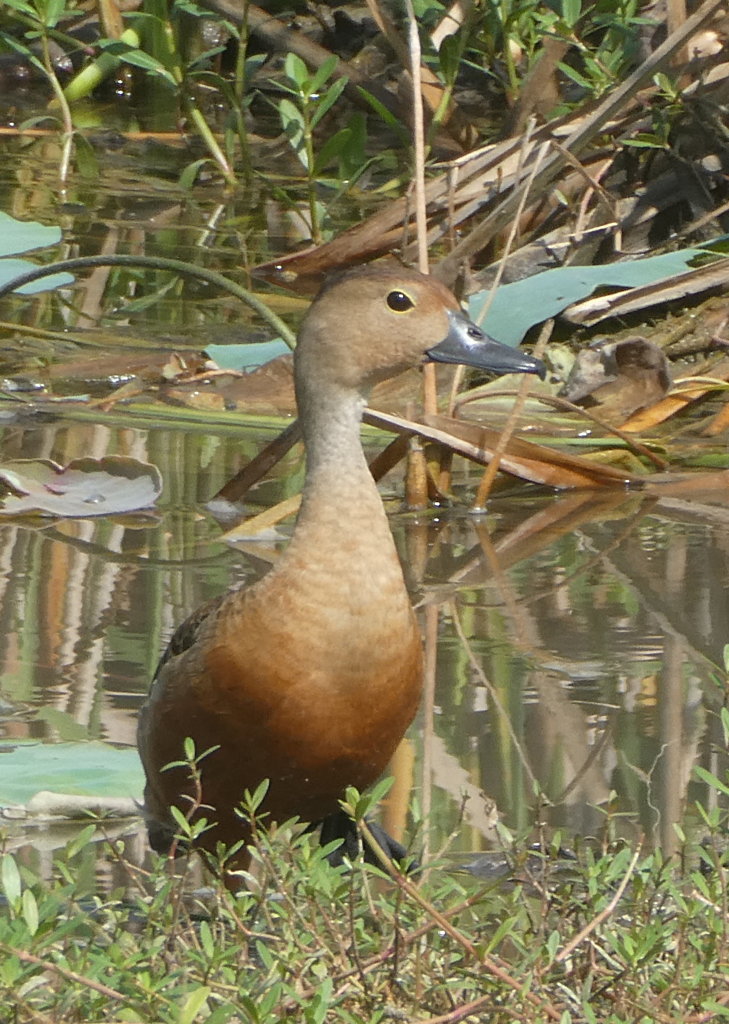
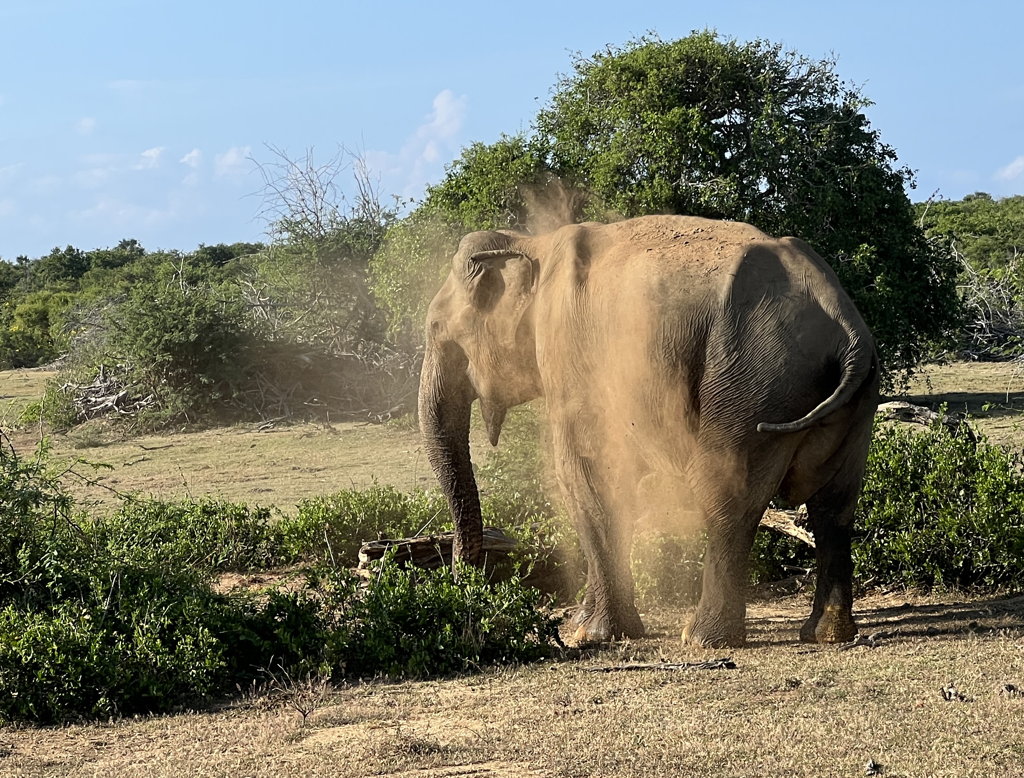

We also encountered a truck with school kids. Nice to know that the students are introduced to the wonders of their country.
We drove back to the hotel to rest during the middle of the day. In the middle of the afternoon a jeep from Yala National Park arrived with its driver and Ubali. We hopped in, and drove into the park which was right next to our hotel. We saw a few more bird species and a few animals. The highlight was pretty much failing to see a leopard, though at one point Dave did see some spots moving way back in the brush. The annoying thing about the leopard was that there were a dozen jeeps all jockeying for position — it was actually pretty ridiculous. All the reviews of Yala mention that you will see tons of jeeps with tourists and maybe a leopard.
We watched a large male spotted deer digging in the ground for a while, like a dog burying a bone. Apparently they do this to mark their territory.


Back to the hotel, delicious noodles, and sleep.
Monday, April 3
Having had our day of Nature, we checked out, tuk-tuk’d up to the road, and Ubali drove us to the first sight of the day, a massive rock with seven figures which had been engraved on it hundreds of years ago. After the Taliban destroyed the Buddhas of Bamiyan, the Buddha in the center of this one became the tallest remaining Buddha figure in the world. The figures had been covered with plaster originally, and a bit of the plaster remained. Afterwards we had some wood-apple juice, not too sweet but a juice we’d never had.
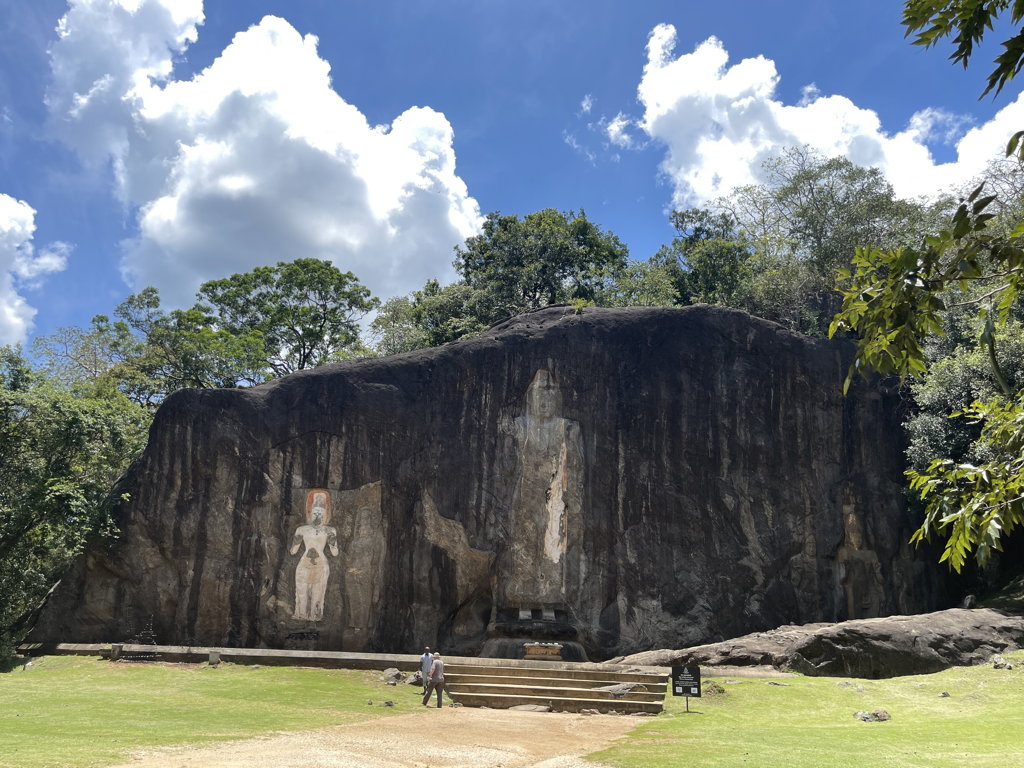
We proceeded from there to Ella, a cute little mountain town. On the way there was a waterfall with dozens of tourist stands and standing tourists along the road, reminding us of Romania. In Ella we walked to the Nine Arch Bridge, and hung out for an hour or so waiting for the train to pass over it. Ray met some Sri Lankans, and Dave met some Iranians while we were there. One also hears lots of Russian. The guide explained the story of the toddy-honey-jaggery progression of palm juice, as the sap is reduced further and further. This story was repeated by others along the way. It’s clearly something they want the visitors to learn.

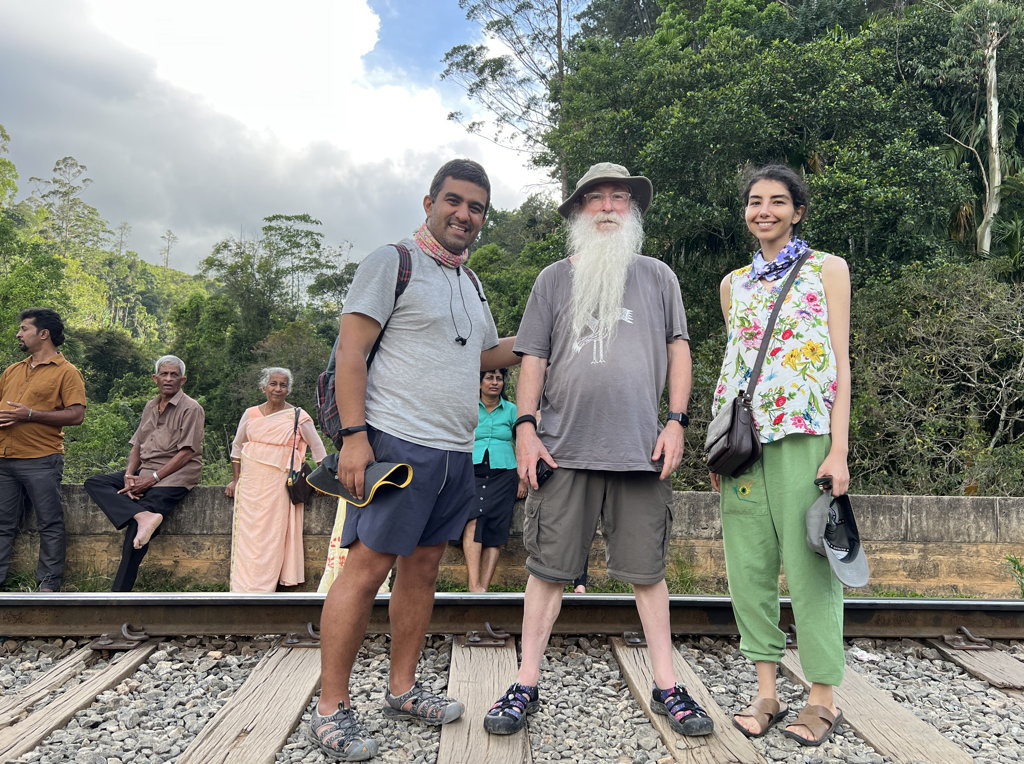
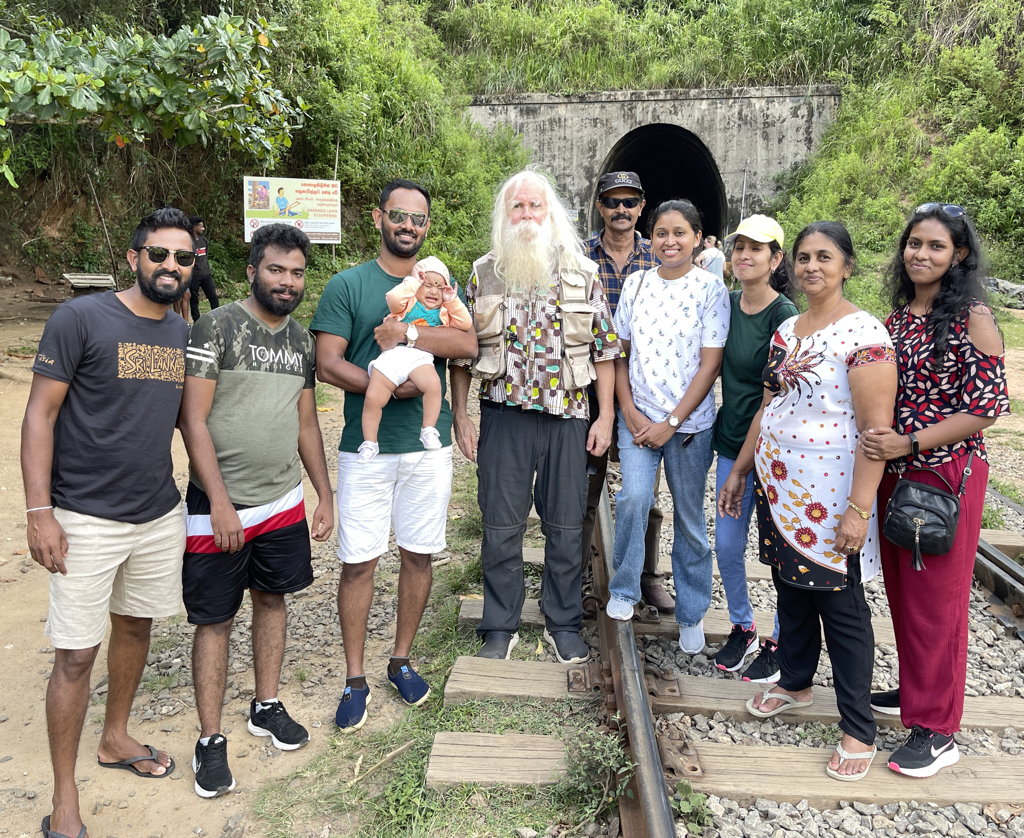
We stayed in a “homestay”, pretty much an airbnb. It was on a twisty little road accessible only by tuk-tuk. They didn’t serve dinner, so we took a tuk-tuk to Matey’s Hut, which served delicious Sri Lankan rice & curry. Their basic plate was four vegetable curries of your choice, rice, papadam, and an optional chicken curry. They were out of several items, but we still found enough to be interesting. The jackfruit curry was definitely the winner, being nicely spicy and having a variety of textures. It was crowded and cheap and popular with the tourists. There are a lot of tourists in Ella. Not all from Europe; Sri Lankans who live near the coast come up to the Hill Stations to cool off.
Tuesday, April 4
We took the tuk-tuk to the train station, where we met Ubali. We put our packs in his car, and boarded the train. The original idea was to take it to Kandy, our destination for the day, but he recommended getting off at Nanu-Oya, which most people on the train decided to do as well. We went past dozens of tea farms in the scenic hills. The most fascinating part of the train ride was the sound which had a continually varying rhythm as it went along. Perhaps small variations in how the track was installed can cause that.
I had visualized this as a kind of toy train, like the one to Darjeeling or the ones that traverse different parts of the redwoods in California, but it’s part of the national rail system, and people use it to get from one place to another. The weather was good on the part we took, but when we got off, it turned rainy.
There wasn’t anything I felt I had to see in Nanu-Oya, although they did have a nice old post office where I bought some cards (including a photo of the nice old post office). Ubali drove us past several large tea plantations. We stopped at Blue Fields Tea Gardens and had a factory tour, learning that the same leaves are used to make black tea, green tea, and white tea. The black tea is fermented, the green tea isn’t, and the white tea is made from leaves of a particular shape. But no photographs were allowed in the factory. Didn’t seem there was anything super advanced and proprietary there, though. We tasted tea in the tasting room, and didn’t buy any because then we’d have to carry it around for several more weeks, and worry about the agricultural requirements of several more countries.
We drove to Kandy, staying in a little hotel, St. Bridget’s Country Bungalow. We picked a well-reviewed restaurant, High Tide, to check out for dinner. Again, a tuk-tuk took us into town. It was three months old, and featured crab curry, using crabs from the sea, caught off Colombo. Unfortunately, one of the crabs tasted a little bit of ammonia, which is a decay product of crab: Dave was well-acquainted with the taste after his first and last visit to Red Lobster several years ago. Surprisingly, Ray didn’t notice it in his half. We sadly provided feedback to the manager, who comped us dessert.
Wednesday, April 5
Ubali picked us up, and then picked up Dhanushka Liyanage, another guide in town, to take us on our “village walk”. He specialized in birdwatching, and they picked him because we’d expressed interest. He carried a camera with an enormous lens and took some great pictures of several of them. He had recordings of bird calls so he could trick a few of them into coming out into view. He was great, and if you go to Sri Lanka, look up “Paradise Island Safari”.
Unfortunately, nobody had told us that we were going on such a walk, and we were unprepared with only one set of binoculars. This was the single most egregious mistake made by our tour operators — they seemed to like surprises, but generally, we don’t. The other thing they didn’t tell us about before we left was that there were leeches on the wet parts of the trail. They gave us special leech socks to put on which theoretically are impenetrable, and wear leeches out when climbing up them. They didn’t completely do that, though, we each ended up being bitten twice, on legs and torsos. Perhaps if we’d tucked in our shirts, the torso bites would have ended up on our neck or somewhere.
The first section took us past row houses – huts – built by the British for their workers. The next village had a policeman there trying to defuse an argument about a theft at a campsite. Then came a long section in the forest. The elevation was high enough that we didn’t completely get dehydrated or worn out. The guide pointed out cardamom weeds. This exotic plant for which we pay high prices in America, is in Sri Lanka an invasive pest, brought in from the Spice Islands, and they are trying to eradicate it. We ate some pods to prove to ourselves it’s the same seed.
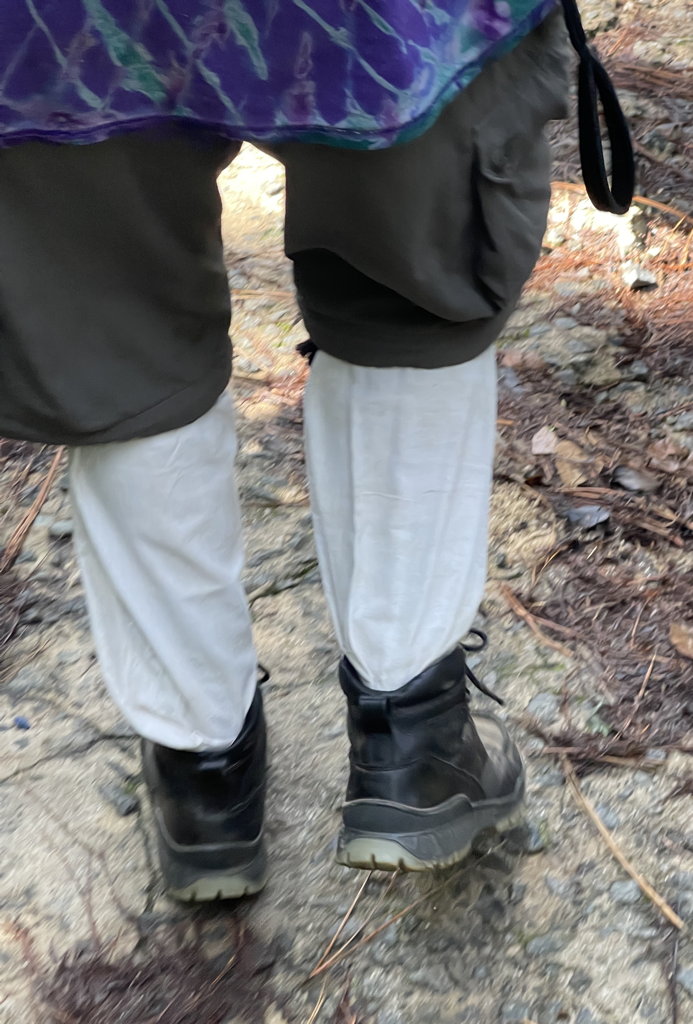
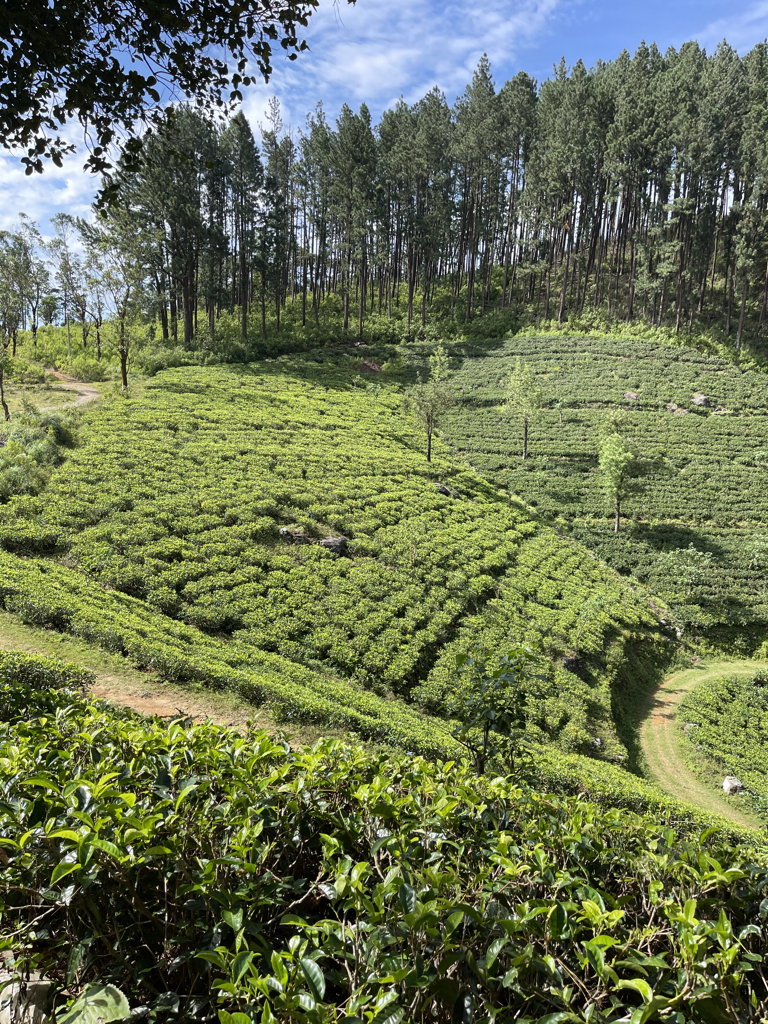

A small Shiva lingam protects the trail to the forest. Sri Lanka is a sometimes uneasy amalgam of Hindu and Buddhist, Tamil and Sinhalese. Ubali has a Buddha on his dashboard. Kandy is about in the middle, and has Christian churches and also mosques.
The walk ended up in another village, a community which lives off the grid and has little contact with the modern world except through excited tourists. All the rice farming is done entirely in the traditional way with no mechanization. We had lunch in a family’s house, with a delicious spread of about seven different curries.
We went back to the hotel and rested, and had the hotel fix us a small dinner.
Thursday, April 6
We ate breakfast at the hotel, and then resumed driving. The first stop was Dambulla, another two-thousand-year-old Buddhist cave temple. This had five rooms. The first one was ancient and claustrophobic with a large reclining Buddha carved out of the rock. The second was fairly large with many Buddhas, dominated by an elaborate one carved out of a single rock. It also featured “holy water” dripping from a spring. The third one was 300 years old and had the best lighting, with a variety of Buddhas. The fourth and fifth were smaller and less interesting. The cave was at the top of a long staircase: you needed to remove your shoes, but if you didn’t have socks, you had to walk barefoot across the hot ground which had been heated up by the sun. Like walking on hot coals — it’s all about the suffering.
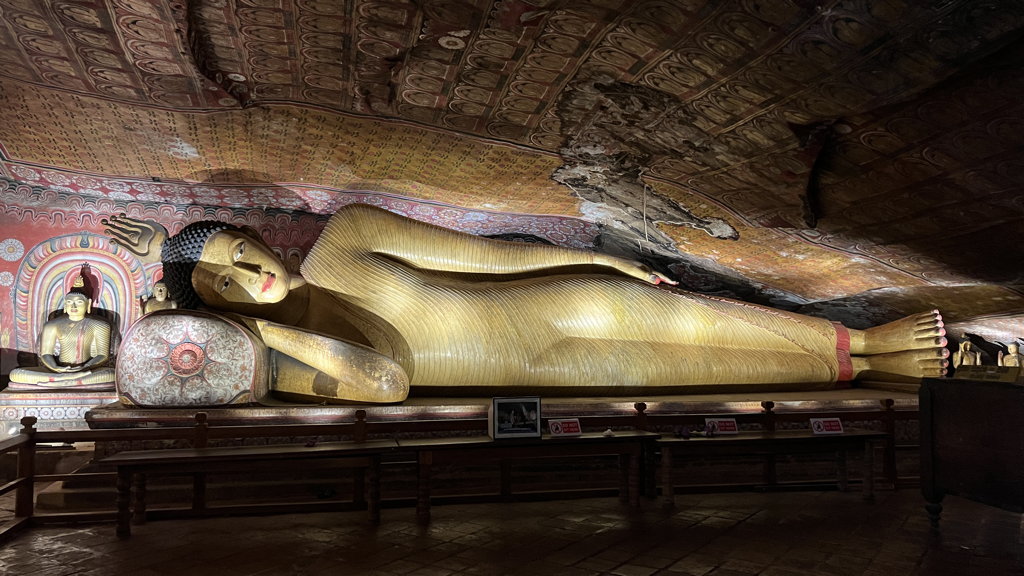

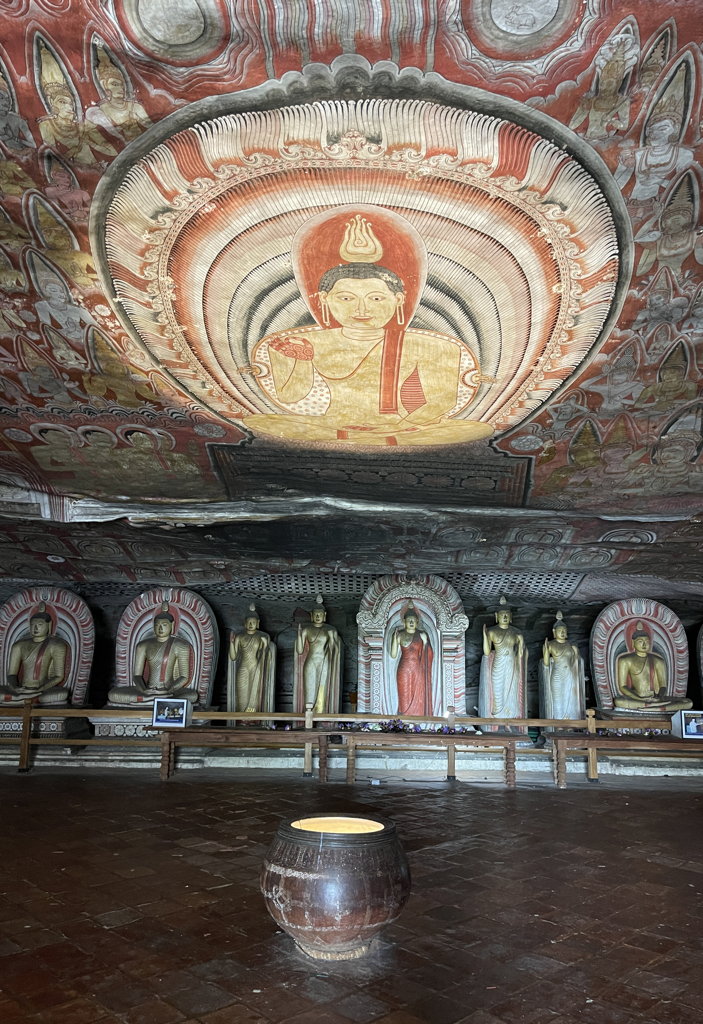

We then headed out to our next destination, Batticaloa, a town on the east coast. The lagoon contains flying fish which are advertised as “singing”, making noises when there is a full moon. There was a full moon that night, and after having a delicious lagoon crab curry, we went out in a small boat to listen for the singing fish. The idea was you put an oar in the water, and put the handle up to your ear. I definitely heard some tonal buzzing sounds, but it seemed like it was maybe one or two fish, not the large group of them that they were expecting. Ray, whose hearing has declined recently, didn’t hear anything at all. It was a little disappointing, but we tried. If they were serious about proving the fish are a real experience, they’d invest in an underwater microphone and some headsets.
Friday, April 7
After breakfast, we drove back west to Polonnaruwa, a large temple complex. The guidebooks say that it is in better shape than Anaradhapura so I had selected it when planning a tour with the guides. It was the second capital after Anaradhapura, in the years 1070-1310. Naturally it was overthrown and burned. You don’t get to be a world heritage site by surviving intact without drama. Polonnaruwa features a museum and ruins of a large monastery, spread out over hundreds of acres. Of all the sites we’ve been to on this trip, it’s the most impossible to imagine seeing in a day. On the other hand, it was hot, and spread out, and though we hardly saw but a corner of it, I was tired. We ended at a reclining Buddha. At least somebody gets to lie down.
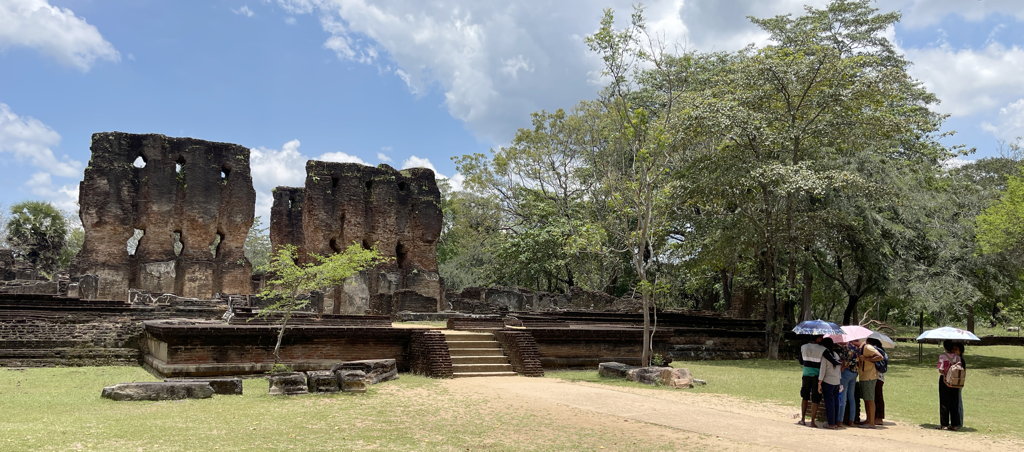

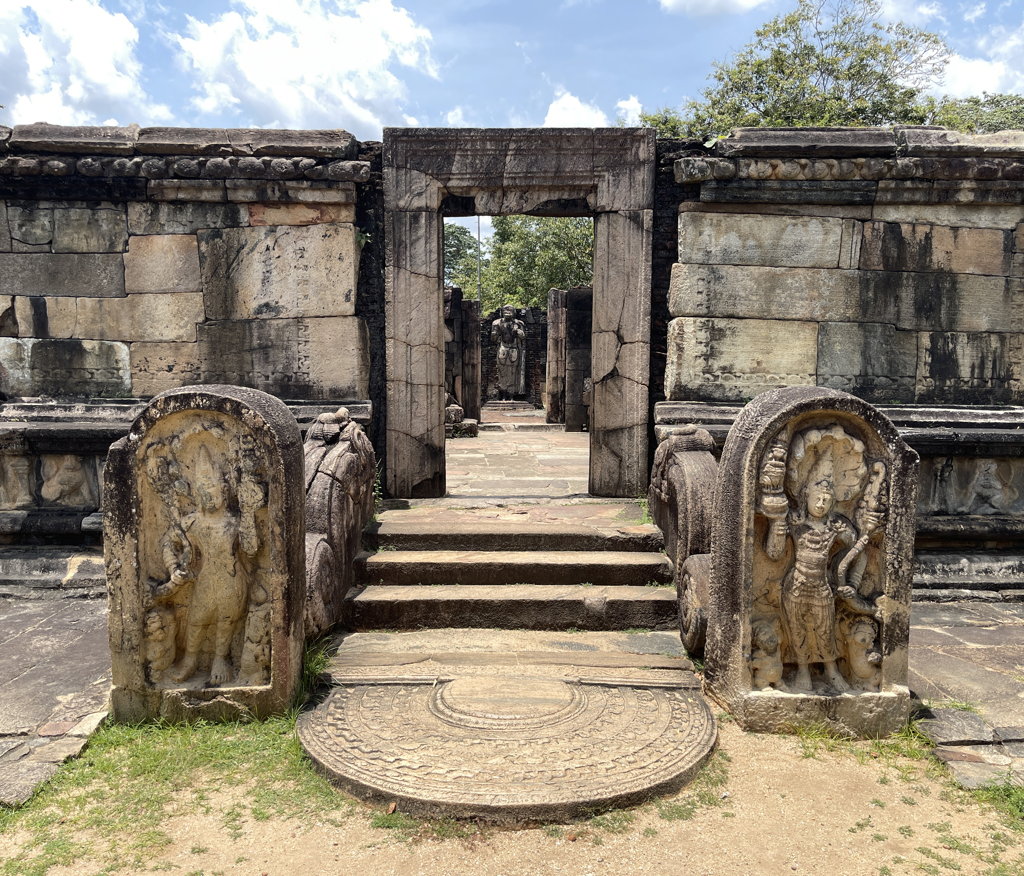

Later we went to Minneriya National Park on a little safari. It was supposed to have a large number of elephants, but the weather or water level was not right somehow, and we didn’t see them. We did see several other animals, especially birds. There was a displaying peacock at the front entrance. As soon as the truck started up, he furled. Clearly just for the tourists.
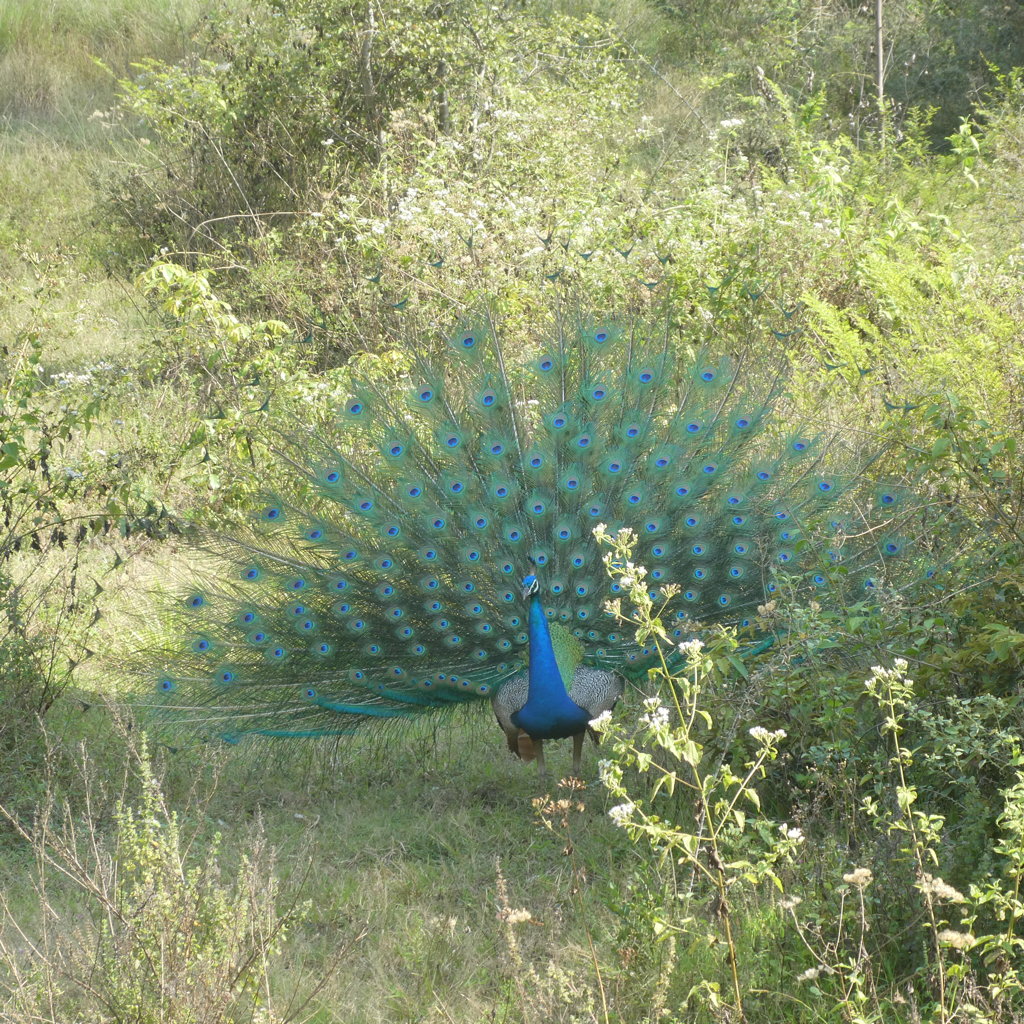
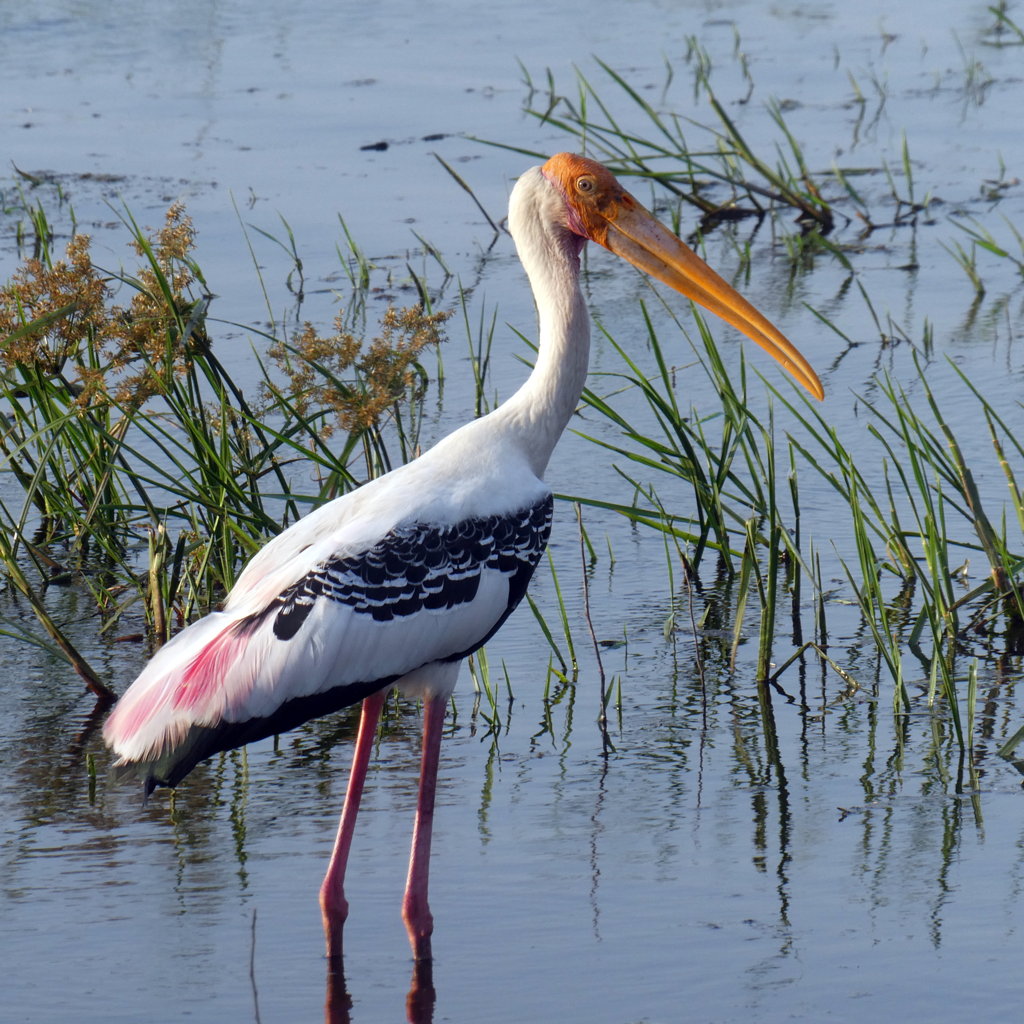
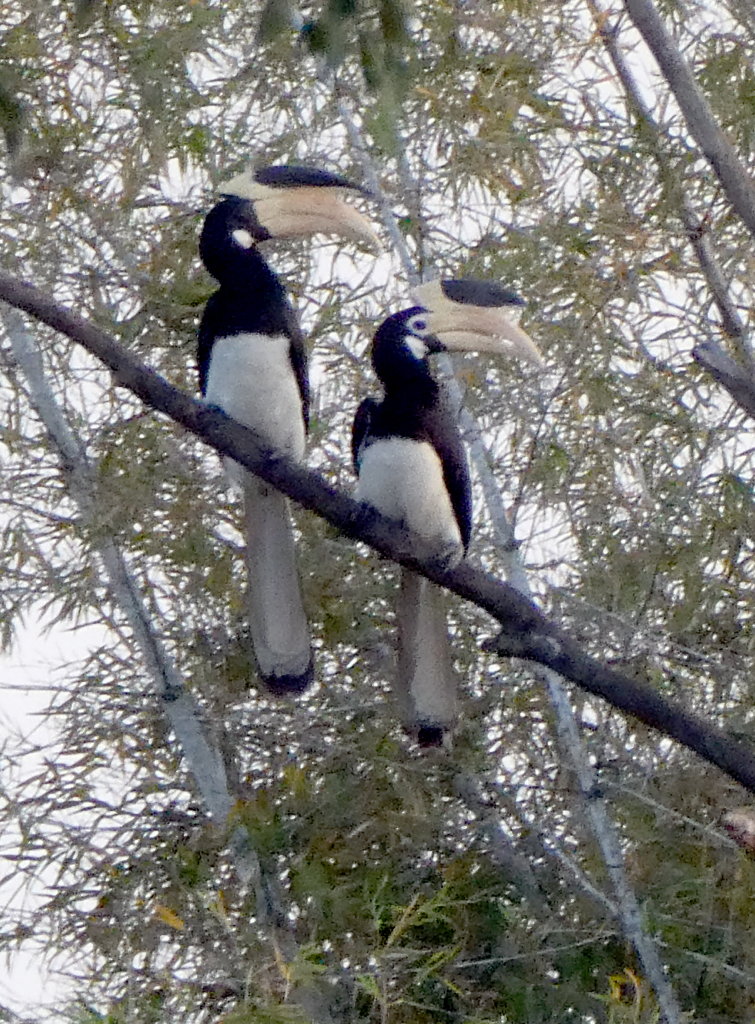
Going to the hotel was interesting. We went to a corner, and waited for a little truck to arrive to get us. It was after dark by the time it did. We got in the truck, which took about forty minutes to go 4.5 km on a bumpy little unpaved road. The stunning part of this adventure was the fireflies, which used to be all over America but are now mostly extinct. The truck driving along the road must have stirred them up, because it left a trail of lights, which we could see outside the back because it was just an ordinary troop carrier (and I don’t mean the trademark, I mean a pickup which is open at the back, with only a cover). You get the same effect running your hand through a phosphorescent bay during one of the glowing tides that visit Jamaica and Puerto Rico and occasionally Half Moon Bay, California.
Finally we ended up at “Back Of Beyond”, a “tree house” complex. Our tree house had a bathroom on the ground level, and a bed on the platform above. The platform was open to all — no walls or locks or anything (there was a tiny safe). While there were very few people around to distrust, it was in the forest, which has elephants and buffalo and most mischievously, monkeys. They said they’d never had any problems with monkeys (though a friend of ours had stayed in a tree house once somewhere where monkeys definitely broke into his pack and messed stuff up).
I wrote a review:
“Let me describe what you will actually be getting if you stay here. You will be on an elevated platform in the forest by a swamp, with only a back wall — a stage, essentially. Bring your Edward Albee and Henrik Ibsen scripts to perform for the forest. Scripts on paper; there is no WiFi and no cell phone coverage. None. Just like a northern Mexico kidnapping. And did I mention their English is several words short of rudimentary?
“Back Of Beyond” is not even a treehouse camp, it is LARPing a fantasy of how the simple brown people lived before those wicked cis- white publicly heterosexual males showed up with their Christianity and their genocide and their property and their Attachment and their germ theory of disease. A wooden platform in a tree with a mattress on it is not a camp. Campers do not leave the bed netting artfully parted with a light on behind for Interior Design effect, and those of you who have any experience of camping or of the tropics are excused from clicking on “You’ll never guess what happened next.” A camp has provisions for security from wild animals such as monkeys raiding your wide open unlockable unclosable room platform to steal anything shiny. This didn’t happen because I kept everything in the bed.
When I was a child the lack of connectivity didn’t exist either; but phones characterize human interaction in 2023 and one is much more isolated without them than one was in the 1950’s before they existed. I keep thinking I should get a satellite phone, but this is the first time I’ve thought that in a place that calls itself a hotel.
I’m not saying this is a bad establishment, it was just inappropriate for us when we hoped to do laundry and had some issues to deal with that required communication.
All I am saying is, be prepared for this experience.”
I don’t think I posted the review. I was mad, at the time.
Combining the monkey threat with the lack of cell or WiFi coverage, and the forty-minute drive, and the inability to do laundry, we decided we didn’t want to stay there a second night, and arranged to spend the second night at the place we were scheduled to be the night after.
Saturday, April 8
In the morning, we bailed on the treehouse. I hadn’t slept well. We were driven back to the place where the car was parked in the taxi which was tough on the spine. An electrical wire was down over the access road. The drivers got out to put it back in place.
We met our bird watching guide and went for a walk in the Sigiriya forest. It was fairly successful. I didn’t feel at the time we were seeing a lot of birds but now that I look at my notes, there were about thirty species pointed out to us, as well as a Giant Squirrel which is kind of a giant rat. Everyone is in marketing.
Ubali met us at the other end of the walk, and it was time to do what we couldn’t do at the Back of Beyond: get our Australian eVisas!
In 2012, I had never heard of an eVisa. We were going to Australia and the ticketing counter lady said we needed one and we said huh? and went on line and got them after answering a few questions and went and got our boarding passes. It seems to me that was the same moment that the dad came up and told us his tiny son was absolutely convinced we were Santa Claus and could we play along? The memories seem to be on the same mag tape.
However, it is different now. Platoons of unemployed security consultants and really, really, stupid web designers have got to the Australian government and told them that their process was much too transparent. And of course, it needs to be an app.
We went to the Ekho Zinc cafe, which has reliable WiFi.
Australia still wants your passport number and birthday, but the real challenge is that you have to submit a photo. The Australian ETA app uses the original facial recognition algorithms used to keep track of convicts being transported in 1765. It must have been twenty minutes trying to get it to lock on to my face, with all different lighting and expressions. Makes me think I should become a bank robber when I get there, the security cameras would be all “hold/no face detected” and “tilt up”.
Go get an eVisa from Australia, see if it was just us.
After that, it was time for Culture, which meant climbing up Lion Rock, the vertiginous summer palace built by King Kashyapa during the 5th century. It has a commanding view of the plains around it. There were also monks studying there. A fancy water system drove fountains from the water falling on the rock. The modern setup allows tourists to walk to the top on stone steps near the bottom, and flight after flight of steel stairs the rest of the way. When you’re going back down, there’s a little cave with paintings of topless women serving things. You’re not allowed to take pictures of them, but we got postcards of a few of the paintings. They’re all in pretty good shape.


Take water. Ray felt faint on the way down because he’d drunk all of his. We got passion fruit juice from the stands in the parking lot at the bottom.
We drove west to the Wilpattu area, found our hotel, Ceylon Resort, which was serving a delicious buffet of home-cooked Sri Lankan curries, including jackfruit, fast becoming my favorite. For some reason, all the other guests there seemed to be from the Netherlands. There was a bird which sang the same four notes over and over — Dave was able to identify it (an Indian Cuckoo) by Googling “Sri Lankan bird call four notes”. We never saw it, but heard it almost all the time while we were there.
Sunday, April 9
We relaxed in the morning, and got picked up for an afternoon safari in nearby Wilpattu National Park. It seemed pretty vast and varied and we saw kingfishers and herons and eagles and mongooses and monitor lizards. But everyone assumes you are there to see the leopards. After not seeing anything in a group of many jeeps, we drove elsewhere, and our driver noticed some fresh tracks. We followed them, and he spotted the leopard who had made them. We watched it move farther and farther away, and didn’t quite get a picture of it, but we saw it! After driving around for quite awhile, and seeing an elephant and many birds, it was time to head back. As we did, there was another collection of jeeps which were all looking at a leopard which had climbed way up a tree. We got a good vantage point, and took some pictures. It was difficult to focus on — our driver got much better pictures of it with my camera than I’d been able to.
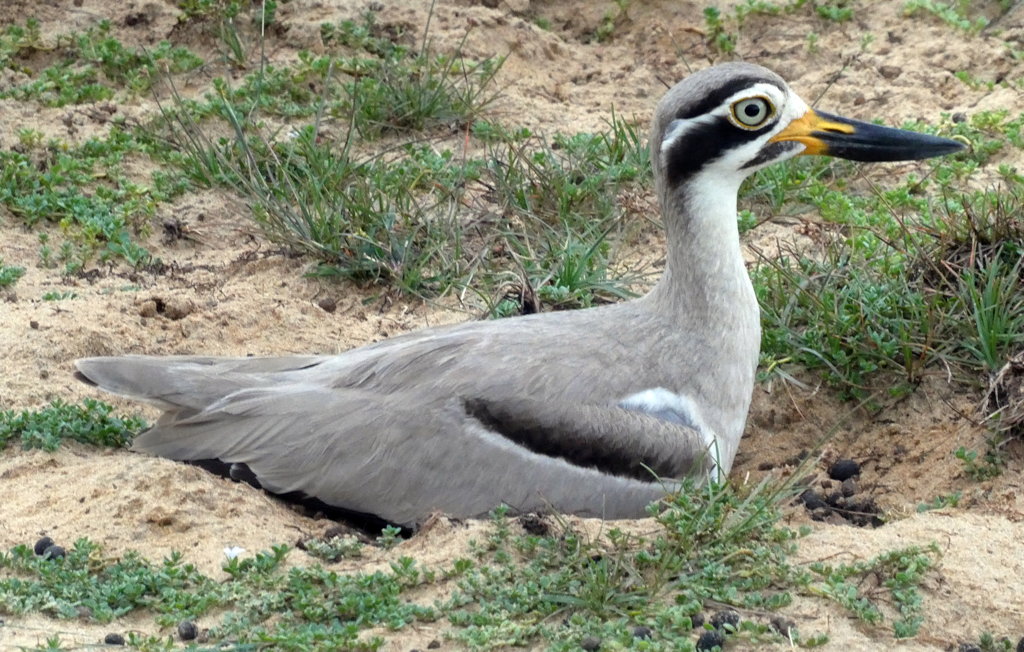
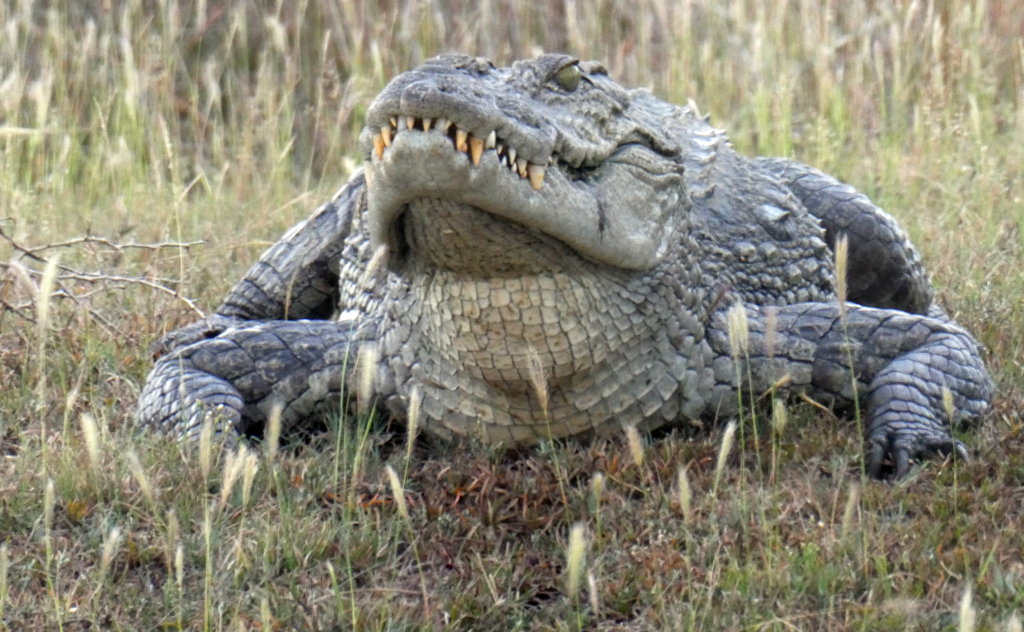
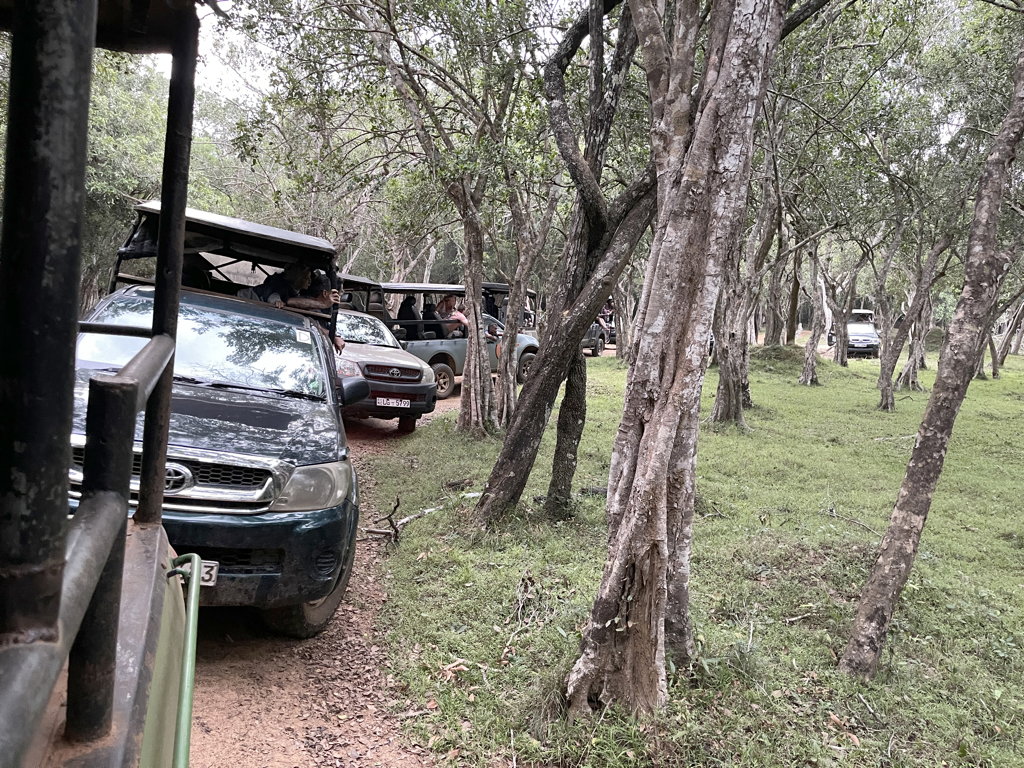
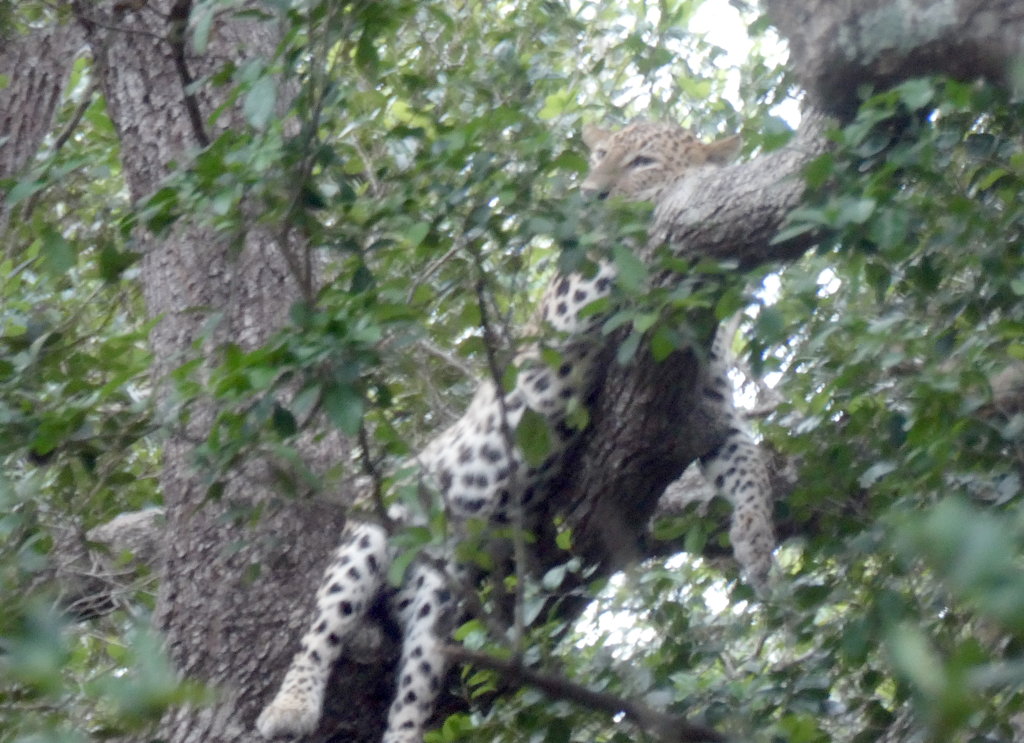
Big Cats aren’t all that magical because they look and act just like small cats. Much more variation between buffalos and cows.
Back to the hotel, and a whole new set of curries for dinner and a whole new set of Dutch people. Also some Russians. Staying at the Ceylon Resort is like being the guest of the family. Among the best food we’ve had in Sri Lanka, original recipes of his mother-in-law and grandmother, if I understood correctly. The owner and Master of Ceremonies, Roshan, lights up the room when he appears. The yard is full of birds, and the ponds, of fish and frogs and flowers. The firecrackers you hear are to keep the elephants out of the garden.
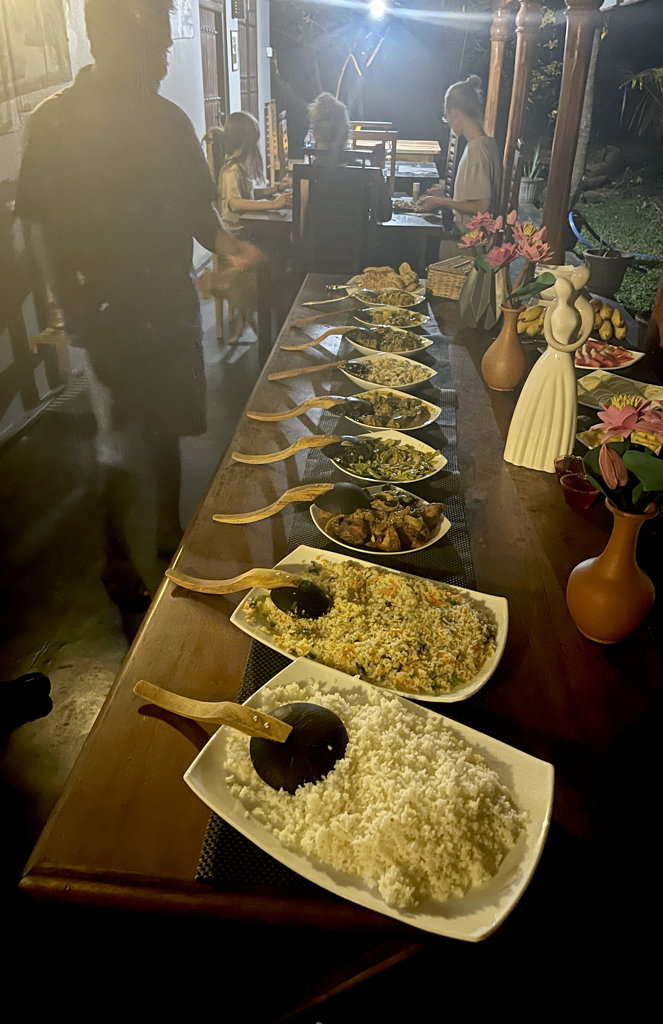
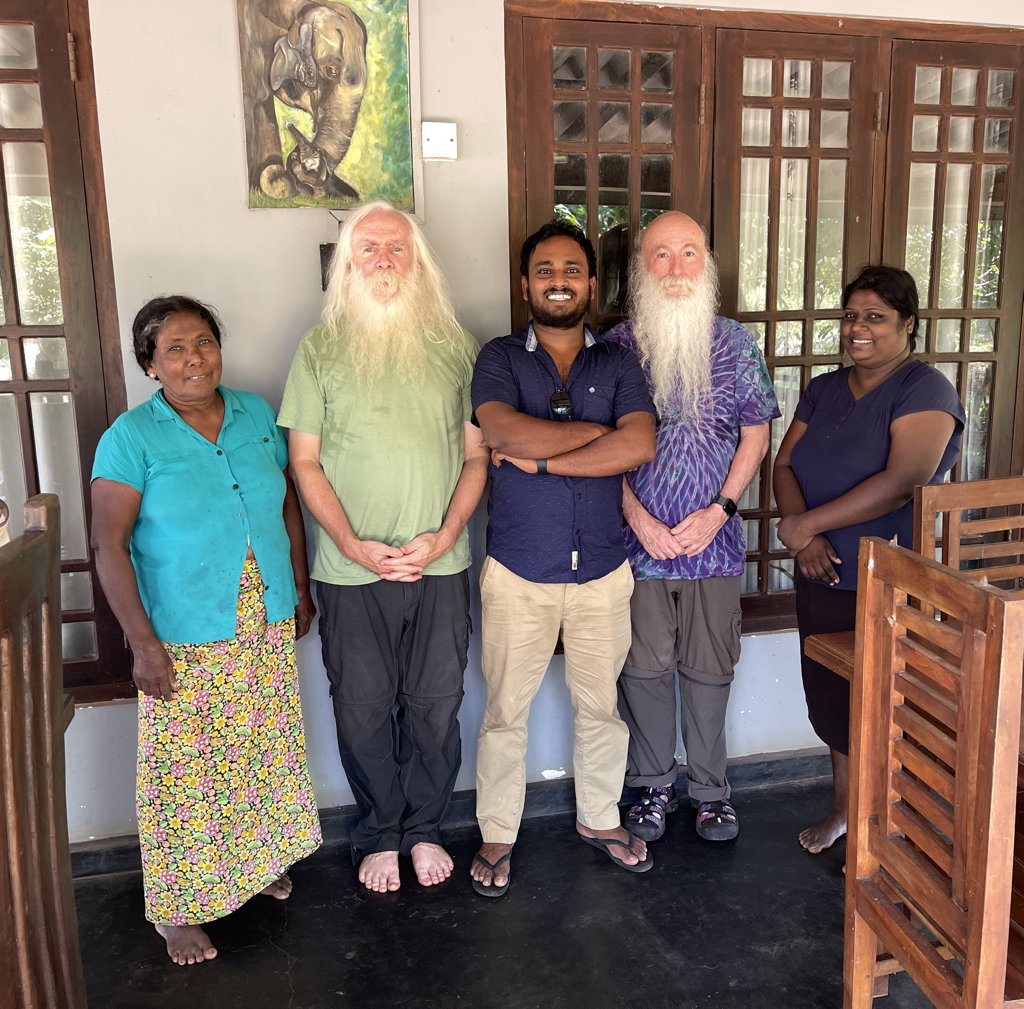
Monday, April 10
After breakfast, we checked out, and drove down to Negombo, a coastal tourist town, and checked into our beach hotel. They “upgraded” us to a room with a direct door to the pool area, but it felt like a downgrade from the “double” we’d booked, to a “twin”, as if they didn’t approve of us. Sigh. They are always trying to be helpful, in the direction of normal.
We picked a place for dinner from Google, and walked 15 minutes up the road to get there. It was a hotel restaurant which had closed down (nobody told Google, oh well). We went to their current restaurant, which had a decent choice of courses in their optional Set Menu. Ultimately it was not really worth the walk. All westernized. Tomato cream soup and minestrone. Sago pudding and treacle. Chocolate cake with weird jellies. Five Sri Lankan curries including banana flower which they called banana leaf. Rice, papadam, tuna tartare
The dramatic part was the thunderstorm happening just offshore as we sat in this covered restaurant which didn’t have walls — the thunder was loud and the lightning was bright. It wouldn’t have been fun to experience that in a treehouse. There must be a cultural trope of eating in a restaurant without walls during a thunderstorm. It happens often. They could have walls if they wanted. Maybe it’s a way of showing off how wide your porticos are, that you can watch the light show and not get wet.
Tuesday, April 11
We had breakfast in the beach hotel, and then Ubali drove us into town where we met our boat guide. Negombo has canals, which were built by the Dutch, but aren’t as groomed as the canals in Amsterdam. We got on a little boat to explore the immense lagoon in Negombo. Many shorebirds hanging out in town, a long drive across the lagoon where we were followed by terns, and then we arrived at a peaceful mangrove area where we moved more leisurely. There were eagles watching for fish, and monkeys just hanging out. At one point we got stuck in a little passage, but got out with a lot of pushing and twisting. We went back across the lagoon, and came up through the commercial fisherman’s district where their boats lived. We saw some traditional catamarans going out to sea. As we arrived at the dock, we saw a coucal, which we’d heard repeatedly, we were told, but hadn’t ever seen. Unfortunately, it didn’t hang around long enough to get its picture taken. The fish market area smells like unfresh parts of fish, but nowhere near as bad as a penguin colony.
We spent the rest of the day in the hotel, and had their buffet dinner, such as it was. Around nine, it was time to go to the Colombo airport (which is actually in Negombo), and head on to Singapore. The flight left at 1:15 AM and lasted about three and a half hours. There was a storm over Indonesia. The pilot told the cabin crew to sit down about a minute before we flew out of it. I wonder what the formula really is, for the various levels of turning on the seat belt sign.
Somewhere along the line my iPhone has lost the ability to take pictures through windows. I wanted to take a photo of all the boats in the Singapore Straits but it insisted, this time and all times recently, in taking pictures of the dust on the window of the airplane, or car, or room that I am in.